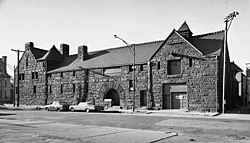Henry Hobson Richardson
Henry Hobson Richardson (September 29, 1838 – April 27, 1886) was an American architect. He designed buildings in Albany, Boston, Buffalo, Chicago, Pittsburgh, Milwaukee and other cities. The style he popularized is named for him: Richardsonian Romanesque. Along with Louis Sullivan and Frank Lloyd Wright, Richardson is one of "the recognized trinity of American architecture".
| Henry Hobson Richardson | |
 Close-up of Henry Hobson Richardson, portrait by Sir Hubert von Herkomer from the National Portrait Gallery in Washington, D.C. | |
| Personal information | |
|---|---|
| Name | Henry Hobson Richardson |
| Nationality | American |
| Birth date | September 29, 1838 |
| Birth place | Priestly Plantation, St. James Parish, Louisiana, U.S. |
| Date of death | April 27, 1886 (aged 47) |
| Place of death | Brookline, Massachusetts, U.S. |
| Alma mater | Harvard College, Tulane University, École des Beaux Arts |
| Work | |
| Buildings | Trinity Church, Boston |
| Design | Richardsonian Romanesque |
Henry Hobson Richardson Media
Trinity Church, Boston (1872), is Richardson's most acclaimed early work
The Thomas Crane Public Library (Quincy, Massachusetts), with Japanese inspired eyelid dormers in the roof on each side of the entrance
The Old Colony station in North Easton, Massachusetts, illustrates Richardson's use of Japanese architectural concepts
Other websites
![]() Media related to H. H. Richardson at Wikimedia Commons
Media related to H. H. Richardson at Wikimedia Commons
- Richardson's present day successor firm, Shepley Bulfinch Richardson and Abbott Archived 2013-11-07 at the Wayback Machine
- Henry Hobson Richardson at the Open Directory Project
- Henry Hobson Richardson at Find a Grave
- The 53 extent Richardson sites and his Brookline, MA house









